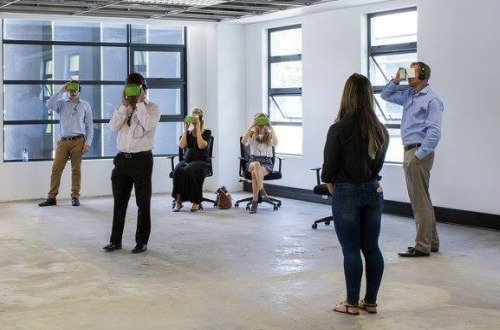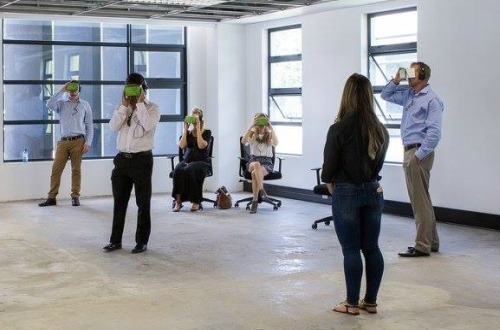
Imagine shopping for your new apartment from the comfort of your own couch or maybe shopping for your next car in a showroom in Detroit while sitting in your office in Johannesburg. This is only just the tip of the iceberg of what Virtual Reality (VR) can offer. VR is opening up opportunities for businesses to connect with their customers in ways that have never been seen before.
Since it made its debut in 2014, virtual reality has grown from video games to uses such as interior design where designers can see and plan within spaces that don’t yet exist, and as medical treatments for autism and amputees.
Statistics reveal that from around 2,000 users in 2014, last year, 43 million people used VR in their day-today lives, with analysts predicting as many as 90 million VR users in 2017.
Although the initial uptake has been rather slow, indications are that VR is expected to have a massive impact in sales and marketing.
In an article looking at the wide-reaching impact that VR will have on all aspects life, Nick Carapanagos founder and MD of Johannesburg-based digital agency CubeZoo, says tech is right now becoming the go-to tech tool for savvy marketers.
“The tech has become a big part of brand activations by innovative companies, providing a one to two minute experience, with an abundance of information presented in a cool way. From generating excitement about the brand to introducing a product or tool by showcasing its many uses and benefits, VR is fundamentally changing what is possible in marketing. We have seen consumers become so excited they have asked to re-experience the VR.
So what does this mean for your startup? Should you even care about VR even if you are not a tech company?
Jason Ried, MD of award-winning SA-based AR development company, Fuzzy Logic, says you should.
“Virtual Reality, and to a similar degree Augmented Reality (AR), are not just new fads that come and go these are progressions in technology that are going to have a profound impact on our lives. It’s going to be much like mobile or PCs or cars and I might even say like the printing press.
While virtual reality is an all-immersive experience in a virtual world that users can interact with, augmented reality, on the other hand, blends virtual reality with real life.
Ried’s company has been behind a number of AR project including their work with Vodacom helping the telecommunication giant, integrate VR elements into their branding activations at exhibitions such animated logos, maps and information through a phone’s camera; Mystic Mug AR, a quirky fortune telling mug that, when you point your camera at the mug, a personalised fortune pops up on your smartphone and Scan and Play that was used with children’s t-shirts sold in Woolworths stores throughout South Africa, the app activates a different AR experience depending on the t-shirt design.
Reid speaks with SME South Africa about whether the South African customer is ready for virtual reality and why this isn’t just a trend you can ignore.
See Also: Google’s New App Puts Virtual Reality On Your Smartphone
VR is already talking over sectors like gaming, medical and training
In terms of VR, games are doing quite well, they are the leader in driving adoption. VR is really good for training right now. Within the medical field VR us allowing trainees to engage with their hospitals and managers around the country in a virtual environment and helping them to experience things as if they were there.
I tell all my clients that VR is definitely going to influence their sectors
Five years ago we saw the potential for augmented reality and virtual reality and artificial intelligence. A lot of businesses are going to start looking at how they can use AI to make things more streamlined by how they can learn quicker and take advantage of Big Data.
And then with augmented and virtual reality it will be how they can engage with their clients at a much deeper level. You can understand more about your clients and offer them an deeply immersive experience.
Because these are all done on digital platforms, there’s the ability to then use that data to feed it back into the system and use AI to learn again. The result of all of this is exponential growth.
Customers are excited by VR and respond to our client’s campaigns
It’s kind of tricky in that it’s pretty early for the South African customer, and there isn’t that kind of data yet. But I think overall the South African customer loves VR interactions. And so even though it’s early days every time that we come to see people interact with them they get very excited.
Although VR uptake in SA has been slow, we are seeing great promise at Fuzzy Logic
South Africa has really started to take VR and AR very seriously in the past couple of years. It’s mostly the big corporates because they’ve got international exposure and that helps drive the desire to understand what their international competitors are doing.
But what we’ve seen is there’s a definite upswing in the smaller companies being interested in AI, AR and VR and one of the reasons for that, I think is because traditionally South Africa is a little bit behind in tech or in new developments but now and then we take a very big leap forward and part of that leap is because of the abundance of mobile devices. There are lots of cheap android devices and lots of people can now afford them and that’s just made developments more viable.
You don’t have to target the high-end experiences, you can also now target solutions that are specific to a client and budget and also specific to the South African audience. So we think South Africa is picking up very nicely now
My approach to VR is create something that will add to people’s lives and not replace it
So when they do get the interaction that then can benefit them and add value to their lives, I think that’s when we’ll see the real traction gaining in South Africa. It’s why Pokémon Go did very well. Very cool implementation of AR, it kind of allowed players to experience Pokémon in a way they’ve never played before.
I think when you start to see examples like that in business applications or just general apps you can see how both VR and AR are going to become quite impactful because it will create something that will benefit their everyday lives rather than try and replace it.
I don’t see VR and AR as just a fad, so entrepreneurs should seriously get with the program
These are really big jumps in technology that are going to transform the way people interact and the way they behave in this digitally connected world. I think with all major transitions it’s difficult to know the benefits upfront and its difficult to then jump on, but I would just say to all the entrepreneurs out there – read up on these areas, try to understand them and if you can’t think of an integration that would suit your business (which would be very difficult).
What I always tell clients who are new to the technology is to start slow
With everything new you take baby steps, see if it works on a small scale before you try to change the world.
Augmented reality is much simpler in that we keep you in our world and we add additional elements in your world. The upside there is you don’t have to do anything different you just need to pick up the camera or your smart glasses, which are going to be coming along very soon.
See also: Using tech to help your startup connect with customers (and potentially disrupt your industry)
VR is pretty awesome but I certainly think AR is better
[When deciding which is better] It really does depend on your business. What it does need is understanding your objectives and your approach to sales and then building that VR or AR experience around that.
If we’re looking at it from a purely sales perspective VR is a pretty cool tool but I would almost say that AR is a better tool.
So for instance if you’re trying to release a product say, a new car; in creating a VR experience it will look amazing because ultimately you can put that car in a virtual showroom and you can walk around and see it and it’ll look very cool.
But it would actually be cheaper if you do a similar experience with AR because all you have to do is develop the AR element that you overlay into any real showroom with computer generated layers of information such as sound, graphics, video or animations. And through any mobile device you can see, for examples, the car’s specs.







